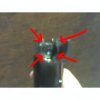roadrider18
Member
- Joined
- Feb 11, 2007
- Messages
- 16
Tuner (and others)
Just a tad bit east of you outside the capitol city. My porch is still intact and all my dogs are out chasing critters!
Anyway, I have a Colt Series 70 (70Bxxxxx) that I am getting ready to overhaul.
About 1000 rounds ago, I was given an early Dywer "Gripper" short guide rod to use. We've all read the threads about the merits of this rod, but, I did notice improved groups. BUT, I also altered my grip and stance some, so I don't know if it was the arrow or the indian.
During, my last cleaning I noticed a circular groove being worn into the frame on the vertical portion just forward of where the slide grooves begin.
It would seem that during the firing cycle, the guide rod face is being slammed or being pushed back into the frame under great pressure causing the indention. After referring to Kuhnausen's article in the "American Rifleman" (Aug 1999) 'How Does It Work' the guide rod appears never be out of contact with the frame. So I am curious how this indention is being formed? Obviously, the guide rod is made of more dense material than the forged frame. But, I've never seen this and nor do any of my other 1911's (Colt and SA (all prior to 1981)) show this wear. they all have short GI guide rods.
The rear face of the the Dywer guide rod fit perfectly into this groove.
I have been shooting a 18.5# Wolff, 230gr ball at 825fps. with a buffer.
My million dollar question?
Should I be concerned? Should I file the are flat?
I am going back to the GI guide rod during the rebuild with a ISMI CS spring of either 16 or 18 depending on which reload I'm shooting.
Thanks for any help and advice.

Just a tad bit east of you outside the capitol city. My porch is still intact and all my dogs are out chasing critters!
Anyway, I have a Colt Series 70 (70Bxxxxx) that I am getting ready to overhaul.
About 1000 rounds ago, I was given an early Dywer "Gripper" short guide rod to use. We've all read the threads about the merits of this rod, but, I did notice improved groups. BUT, I also altered my grip and stance some, so I don't know if it was the arrow or the indian.
During, my last cleaning I noticed a circular groove being worn into the frame on the vertical portion just forward of where the slide grooves begin.
It would seem that during the firing cycle, the guide rod face is being slammed or being pushed back into the frame under great pressure causing the indention. After referring to Kuhnausen's article in the "American Rifleman" (Aug 1999) 'How Does It Work' the guide rod appears never be out of contact with the frame. So I am curious how this indention is being formed? Obviously, the guide rod is made of more dense material than the forged frame. But, I've never seen this and nor do any of my other 1911's (Colt and SA (all prior to 1981)) show this wear. they all have short GI guide rods.
The rear face of the the Dywer guide rod fit perfectly into this groove.
I have been shooting a 18.5# Wolff, 230gr ball at 825fps. with a buffer.
My million dollar question?
Should I be concerned? Should I file the are flat?
I am going back to the GI guide rod during the rebuild with a ISMI CS spring of either 16 or 18 depending on which reload I'm shooting.
Thanks for any help and advice.

Last edited:

